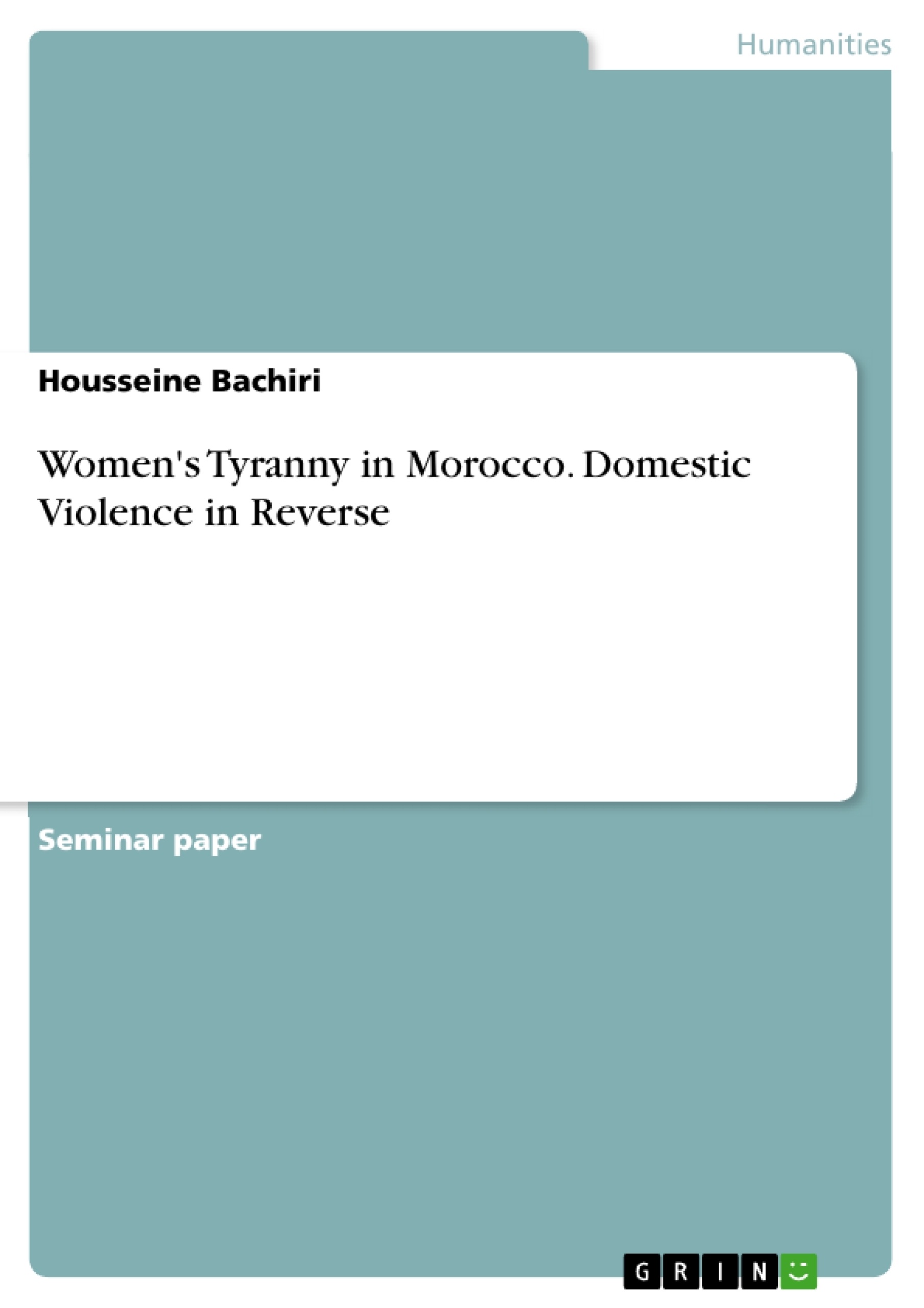This paper examines the other side of gender violence. Domestic violence is not always about men being victimizers and women being victims. In this study, I tried to investigate the opposite of this assumption.
It is generally assumed that, in our Moroccan culture, women, the fairer sex, are the victims of abuse and ill-treatment on the part of their male partners, the rough sex. In this research paper, we aim to examine the reverse of this assumption. Specifically, we aim to provide an answer to the question of whether Moroccan women abuse their male partners, and if the answer is in the affirmative, we intend to answer another, related, double question, namely how and why do Moroccan women abuse their male partners? It would be noted that, in the present work, we use the expression "women’s tyranny” to refer to women’s ill-treatment of men by using harshness, cruelty, and violence, and their prioritization of their own selfish interests over those of men. It also implies the violation of men’s rights and the questioning of their manhood. “The term women’s tyranny will be defined and discussed at length in chapter 1”
Table of contents
Acknowledgements
Dedication
Chapter one: General Introduction
O. General Introduction
O.O Introduction
O.1 Rationale
O.2 The basic assumption of the study
O.3 Objectives of the study
O.4 Research questions
O.5 Methodology
O.6 Organization of the work (chapters and sections)
O.7 Conclusion
Chapter two: Review of the Literature
1. O Introduction
1. 1 Stereotypes
1.2 Biological differences between men and women
1.3 The status of women in Moroccan society nowadays
1.4 A cultural approach to gender and language
1.4.1 Examples of gender differences
Minimal responses Questions
Turn-taking
Verbal aggression
1.5 Tyrant
1. 6 Fiction
1.7 Women’s tyranny
1. 8 Abuse
1.9 Psychological abuse
1. 10 Forms of abuse
1. 11 Conclusion
Chapter three: Data collection and classification
2.0 Introduction
2.1 Data collection
2.1.1 Methods
2.1.1.1 Observation
Direct observation
Participant observation
2.1.1.2 Interviews
2.1.1.3 Questionnaire
2. 2 Instrumentation
2.3 validity and reliability of the questionnaire
2.4 The distribution of respondents by age and gender
2.4.1 The distribution of respondents by age
2.4.1.1 The distribution of respondents by gender
2.5 Data classified according to themes
Theme 1: Women’s perception of women’s tyranny in the Moroccan cultural context
Statements
1-Women‘s tyranny is an obvious fact
2-Tyranny is perceived by women as
3-In your opinion, women are generally not tyrannical, tyrannical, very tyrannical
Theme 2: Moroccan wives’ ill-treatment of their husbands and the feeling of shame for men to admit so
Statements
4-Many Moroccan wives beat up their husbands
5-In Moroccan society, women ill-treat men and pretend that men ill-treat them
6-Many Moroccan husbands are ill-treated by their wives, but they are ashamed to admit it
9-Husbands do not complain when they are beaten up by their wives
Theme 3: Moroccans and the fallacy that the Mudawana incites wives to tyrannize their husbands
Statement
7- The Mudawana does not incite wives to tyrannize their husbands
Theme 4: Moroccan society’s view of women’s tyranny Statement
8-Moroccan society views women’s tyranny as
Theme 5: Husbands’ responses to their wives’ ill-treatment
11-When my wife ill-treats me, I
Theme 6: Testimonies of informants
Statement
12-I know more than one man who is tyrannized by his wife
2.6 Conclusion
Chapter four: Data analysis
3.1 Introduction
3. 2 Data analyzed according to themes
3.2.1 The age group of informants
3.2.1.1 The number of males and females who participated in filling out the questionnaire
3.2.1.1 The number of males and females who participated in filling out the questionnaire
Theme 1: Women’s perception of women’s tyranny in the Moroccan cultural context
Statements
1-Women‘s tyranny is an obvious fact
2-Tyranny is perceived by women as
3-In your opinion, women are generally not tyrannical, tyrannical, very tyrannical
Theme 2: Moroccan wives’ ill-treatment of their husbands and the feeling of shame for men to admit so
Statements
4-Many Moroccan wives beat up their husbands
5-In Moroccan society, women ill-treat men and pretend that men ill-treat them31
6-Many Moroccan husbands are ill-treated by their wives, but they are ashamed to admit it
9-Husbands do not complain when they are beaten up by their wives
Theme 3: Moroccans and the fallacy that the Mudawana incites wives to tyrannize their husbands
Statement
7- The Mudawana does not incite wives to tyrannize their husbands
Theme 4: Moroccan society’s view of women’s tyranny
Statement
8-Moroccan society views women’s tyranny as
Theme 5: Husbands’ responses to their wives’ ill-treatment
11-When my wife ill-treats me, I
Theme 6: Testimonies of informants
Statement
12-I know more than one man who is tyrannized by his wife36
General conclusion
Limitations of the study
Bibliography
Webliography
Appendix
- Citar trabajo
- Housseine Bachiri (Autor), 2014, Women's Tyranny in Morocco. Domestic Violence in Reverse, Múnich, GRIN Verlag, https://www.grin.com/document/379417
-

-

-

-
¡Carge sus propios textos! Gane dinero y un iPhone X. -

-
¡Carge sus propios textos! Gane dinero y un iPhone X. -

-
¡Carge sus propios textos! Gane dinero y un iPhone X. -

-
¡Carge sus propios textos! Gane dinero y un iPhone X. -

-
¡Carge sus propios textos! Gane dinero y un iPhone X. -

-
¡Carge sus propios textos! Gane dinero y un iPhone X. -

-
¡Carge sus propios textos! Gane dinero y un iPhone X. -

-
¡Carge sus propios textos! Gane dinero y un iPhone X. -

-
¡Carge sus propios textos! Gane dinero y un iPhone X. -

-
¡Carge sus propios textos! Gane dinero y un iPhone X. -

-
¡Carge sus propios textos! Gane dinero y un iPhone X.

